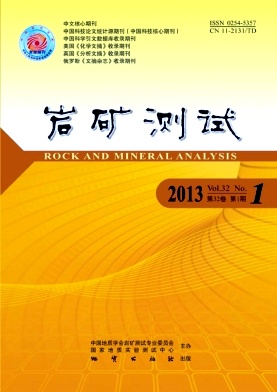| [1] |
Andres N F, Francisco M S. Effects of sewage sludge application on heavy metal leaching from mine tailings impoundments [J]. Bioresource Technology, 2008, 99: 7521-7530. doi: 10.1016/j.biortech.2008.02.022
CrossRef Google Scholar
|
| [2] |
廖国礼, 吴超.资源开发环境重金属污染与控制[M].长沙: 中南大学出版社, 2005: 8-9.
Google Scholar
|
| [3] |
Romero F M, Armienta M A, González H G. Solid-phase control on the mobility of potentially toxic elements in an abandoned lead/zinc mine tailings impoundment, Taxco, Mexico [J]. Applied Geochemistry,2007,22(1): 109-127. doi: 10.1016/j.apgeochem.2006.07.017
CrossRef Google Scholar
|
| [4] |
王志楼, 谢学辉, 王慧萍, 郑春丽, 柳建设.典型铜尾矿库周边土壤重金属复合污染特征[J].生态环境学报, 2010, 19(1): 113-117.
Google Scholar
|
| [5] |
杨明, 罗汉金, 黄颜珠, 党志.大宝山矿区氟污染特征及土壤溶出状态[J].生态环境学报, 2009, 18(4): 1291-1298.
Google Scholar
|
| [6] |
Xiao L P, Li Y, Zhang L. Experimental research on contamination dissolution-releasing characteristics of coal gangue in soaking operation [J]. Advanced Materials Research, 2012, 455-456: 1371-1377.
Google Scholar
|
| [7] |
HJ/T 299—2007, 固体废物; 浸出毒性浸出方法; 硫酸硝酸法[S].
Google Scholar
|
| [8] |
Bermea O M, Chávez A C, Hernández E, Partida E G. Determination of metals for leaching experiments of mine tailings: Evaluation of the potential environmental hazard in the Guanajuato mining district, Mexico [J]. Bulletin of Environmental Contamination and Toxicology, 2004, 73(4): 770-776.
Google Scholar
|
| [9] |
Diehl S F, Smith K S, Desborough G A, White W W, Lapakko K A, Goldhaber M B, Fey D L. Trace-metal sources and their release from mine wastes: Examples from humidity cell tests of hard-rock mine waste and from Warrior Basin coal [M]//Billings Montana: American Society of Mining and Reclamation, 2003: 232-253.
Google Scholar
|
| [10] |
Zhu D, Schwab A P, Banks M K. Heavy metal leaching from mine tailings as affected by plants [J]. Journal of Environmental Quality, 1998, 28(6): 1727-1732.
Google Scholar
|
| [11] |
蓝崇钰, 束文圣, 张志权.酸性淋溶对铅锌尾矿金属行为的影响及植物毒性[J].中国环境科学, 1996, 16(6): 461-465.
Google Scholar
|
| [12] |
王一先, 白正华.矿山尾砂表生地球化学过程实验研究[J].矿物学报, 2003, 23(1): 52-58.
Google Scholar
|
| [13] |
胡宏伟, 束文圣, 蓝崇钰, 王伯荪.乐昌铅锌尾矿的酸化及重金属溶出的淋溶实验研究[J].环境科学与技术, 1999, 13(3): 1-3.
Google Scholar
|
| [14] |
王兰, 刘方, 王俭, 李金娟.铅锌矿渣酸性淋溶下重金属释放特征及其对植物幼苗生长的影响[J].生态学杂志, 2010, 29(6): 1121-1126.
Google Scholar
|
| [15] |
马少健, 胡治流, 陈建华, 陈建新, 林美群.硫化矿尾矿重金属离子溶出实验研究[J].广西大学学报, 2002, 27(4): 273-276.
Google Scholar
|
| [16] |
肖利萍, 梁冰, 陆海军, 毕业武, 张传成, 狄军贞.煤矸石浸泡污染物溶解释放规律研究——阜新市新邱露天煤矿不同风化煤矸石在不同固液比条件下浸泡实验[J].中国地质灾害与防治学报, 2006, 17(2): 151-155.
Google Scholar
|
| [17] |
林美群, 马少健, 王桂芳, 刘平, 苏秀娟, 覃祥敏.环境因素对硫化矿尾矿重金属溶出影响的模拟试验[J].金属矿山, 2008, 38(6): 108-111.
Google Scholar
|
| [18] |
马少健, 李辉, 莫伟, 苏秀娟, 王桂芳, 汪颖.钼矿尾矿铜铅重金属离子溶出规律研究[J].中国矿业大学学报, 2009, 38(6): 829-834.
Google Scholar
|
| [19] |
曹云全, 张双圣, 刘汉湖, 刘伟.煤矸石中重金属动态淋滤和静态浸泡溶出特征研究[J].河北工程大学学报: 自然科学版, 2010, 27(1): 76-80.
Google Scholar
|
| [20] |
Voegelin A, Barmettler K, Kretzschmar R. Heavy metal release from contaminated soils: Comparison of column leaching and batch extraction results [J]. Journal of Environmental Quality, 2003, 32: 865-875. doi: 10.2134/jeq2003.8650
CrossRef Google Scholar
|
| [21] |
Dang Z, Liu C Q, Haigh M J. Mobility of heavy metals associated with the natural weathering of coal mine spoils [J]. Environmental Pollution, 2002,118(3): 419-426. doi: 10.1016/S0269-7491(01)00285-8
CrossRef Google Scholar
|
| [22] |
Dold B. Speciation of the most soluble phase in a sequential extraction procedure adapted for geochemical studies of copper sulfide mine waste [J]. Journal of Geochemical Exploration, 2003, 80(1): 55-68. doi: 10.1016/S0375-6742(03)00182-1
CrossRef Google Scholar
|
| [23] |
Marguí E, SalvadÓ V, Queralt I, Hidalgo M. Comparison of three-stage sequential extraction and toxicity characteristic leaching tests to evaluate metal mobility in mining wastes [J]. Analytica Chimica Acta, 2004,524:151-159. doi: 10.1016/j.aca.2004.05.043
CrossRef Google Scholar
|
| [24] |
Zhang H, He P J, Shao L M, Li X J. Leaching behavior of heavy metals form municipal solid waste incineration bottom ash and its geochemical modeling [J]. Journal of Material Cycles and Waste Management, 2008, 10(1): 7-13. doi: 10.1007/s10163-007-0191-z
CrossRef Google Scholar
|
| [25] |
Jing C Y, Meng X G, Korfiatis G P. Lead leachability in stabilized/solidified soil samples evaluated with different leaching tests [J]. Journal of Hazardous Materials, 2004, 114(1/3): 101-110.
Google Scholar
|
| [26] |
马少健, 王桂芳, 陈建新, 莫伟, 林美群.硫化矿尾矿堆的温度变化和动态淋溶规律研究[J].金属矿山, 2004(10): 59-62. doi: 10.3321/j.issn:1001-1250.2004.10.018
CrossRef Google Scholar
|
| [27] |
Lee P K, Kang M J, Choi S H, Touray J C. Sulfide oxidation and the natural attenuation of arsenic and trace metals in the waste rocks of the abandoned Seobo tungsten mine, Korea [J]. Applied Geochemistry, 2005, 20(9): 1687-1703. doi: 10.1016/j.apgeochem.2005.04.017
CrossRef Google Scholar
|
| [28] |
王俭, 吴永贵, 刘方, 喻阳华, 曾理, 秦中, 苏连文.浸提剂pH值对煤矸石和煤泥污染物浸出特性的影响研究[J].农业环境科学学报, 2010, 29(6): 1144-1149.
Google Scholar
|
| [29] |
Al-Abed S R, Hageman P L, Jegadeesan G, Madhavan N, Allen D. Comparative evaluation of short-term leach tests for heavy metal release from mineral processing waste[J]. Science of the Total Environment, 2006, 364: 14-23. doi: 10.1016/j.scitotenv.2005.10.021
CrossRef Google Scholar
|
| [30] |
于常武, 许士国, 陈国伟, 周立岱.矽卡岩型钼矿尾砂中重金属Mo的淋滤实验研究[J].生态环境, 2008, 17(2): 636-640.
Google Scholar
|
| [31] |
周娜娜, 汤亚飞, 梁震.磷矿浮选尾矿水污染物释放的实验[J].武汉工程大学学报, 2011, 33(3): 33-35.
Google Scholar
|
| [32] |
王俊桃, 毛云, 刘锦梅, 郭迎.硫化矿物中无机盐及重金属离子溶出的影响因素探讨[J].安全与环境工程, 2007, 14(1): 4-8.
Google Scholar
|






 DownLoad:
DownLoad: